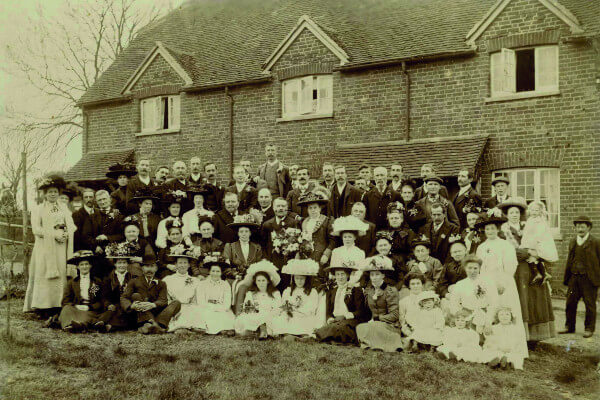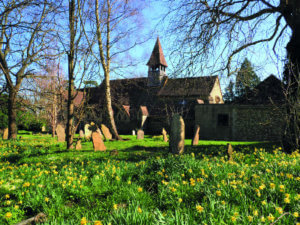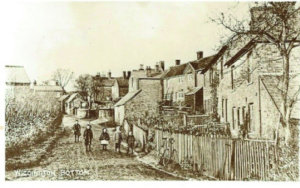Wigginton’s Rich History

‘Wigginton is not a suburb of Tring, but instead a vibrant place with its own distinctive personality,’ says Wigginton History Society member, Richard Tregoning
Folklore has it that in the 18th century, London released all the pimps and prostitutes and placed them in Wigginton – perhaps why it was known in the past as Wicked Wigginton. However, that NEVER happened!
But we do know that the people of Wigginton had some attitude! In the 18th century when the Lord of the Manor of Tring tried to enclose Wigginton Common, the people of the village tore down the wooden fencing and burnt the lot… twice! Even in the 19th century, Wigginton was so remote that strangers were chased out or pushed in the local ponds. There were no cars or buses until 1935, and with steep hills on three sides, making it hard to walk there, this kept the highest village in the Chilterns quite isolated.
The village has a rich history, which may, according to an article in Hertfordshire Countryside in 1967, have started with the Ancient Britons. A wic was a British, Roman and Saxon stronghold – so Wic-ing-ton was the town belonging to that stronghold. The article states: ‘Wick Farm and Wick Wood give some credence to this. Further, what is now the council recreation ground was once known as Polywick.’
 The village was well established by the time of the Norman Conquest. ‘The manor of Wigentone, according to the Domesday Book, was bestowed by the Conqueror upon Earl Moreton, but only the church remains to show that the Normans were there.’
The village was well established by the time of the Norman Conquest. ‘The manor of Wigentone, according to the Domesday Book, was bestowed by the Conqueror upon Earl Moreton, but only the church remains to show that the Normans were there.’
The manor is believed to have been somewhere near what is now Tring’s Natural History Museum.
With its rich history, the village has some fascinating facts and fables within its past. There are also some oddities, and some mysteries…
- Grim’s Ditch runs through the parish – this is a prehistoric bank and ditch earthwork with no defined explanation
- No one knows where the Romans defeated Boudicca in AD 60 but Wigginton has a wood called Boudicca’s wood. Could she be buried there?
 In Fox Road there is a number 96 but only 16 houses, and in Clay Hill, Wigginton Bottom, there’s a number 243 but only seven houses. Why? Because as the First Lord Rothschild had houses, cottages and farms built they were Estate numbered in his records by the date they were built all over the Tring Park Estate. He built more than 243 dwellings until his death in 1915 – the exact number is hard to say, because some of them – like those in Marsworth – never had a number at all!
In Fox Road there is a number 96 but only 16 houses, and in Clay Hill, Wigginton Bottom, there’s a number 243 but only seven houses. Why? Because as the First Lord Rothschild had houses, cottages and farms built they were Estate numbered in his records by the date they were built all over the Tring Park Estate. He built more than 243 dwellings until his death in 1915 – the exact number is hard to say, because some of them – like those in Marsworth – never had a number at all!
More fascinating facts about the village include the fact that William the Conqueror passed by Wigginton in 1066 on the way to Berkhamsted Castle to accept the surrender of London.
And according to the Domesday survey 20 years later in 1086, Wigginton was a place of some importance and boasted two mills.
Several hundred years later, in the 19th century, the village was known for its straw plaiting industry. The Wigginton women had such a good reputation for the quality of their straw plaiting, which was used in the hat trade, that the dealers used to walk up that steep hill to buy from them. In the early part of the century a good straw-plaiter could earn one pound a week, but by 1870 this amount had dropped to just eight shillings. Sadly the industry was eventually ended by competition from China.
Later, Wigginton benefited from the influence of the Rothschilds when the family purchased Tring Park in 1872. They supported the school, the church and the choir. For 25 years, Lady Emma Rothschild owned the Champneys Estate but never lived there. (See our review of a book that focuses on the lives of the Rothschild women.)
With its lofty position, it used to be said that Wigginton was worth a visit simply for the view of Ivinghoe Beacon. Today it has plenty to offer its residents, including a thriving WI with 90 members; an Outstanding rated primary school; a film society; Wigginton Preschool; active Garden and History Societies; The Greyhound, the highest pub in the Chilterns; St Bartholomew’s Church and the Baptist Chapel. The sports field and children’s playground have been recently restored by Wigginton Parish Council, and are situated next to the Wigginton Community Shop, where more than 150 people a day, including walkers and cyclists, come to buy food and snacks.
Wigginton has certainly changed since the days when villagers chased off strangers, and offers far more than just a pretty view.
With thanks to Brenda Scott-Oldfield, Tring Camera Club and resident of Wigginton for the modern images.

